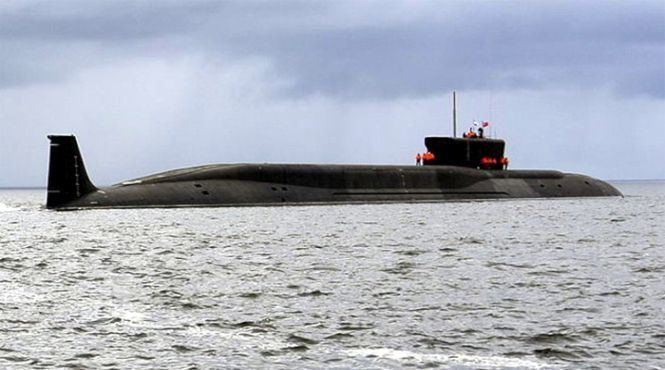Name Arihant In commission 2016 Active 1 Beam 11 m | Building 3 Length 112 m Builder Hindustan Shipyard | |
 | ||
Builders Navy Shipbuilding Centre, Visakhapatnam | ||
Why china and pakistan should fear india s arihant class submarine
The Arihant class (Sanskrit, for Killer of Enemies) is a class of nuclear-powered ballistic missile submarines being built for the Indian Navy. They were developed under the US$2.9 billion Advanced Technology Vessel (ATV) project to design and build nuclear-powered submarines.
Contents
- Why china and pakistan should fear india s arihant class submarine
- History
- Description
- Development
- Ships in class
- References

The lead vessel of the class, INS Arihant was launched in 2009 and after extensive sea trials, was confirmed to be commissioned in August 2016. Arihant is the first ballistic missile submarine to have been built by a country other than one of the five permanent members of the United Nations Security Council.

History

In December 1971, during the Indo-Pakistani War of 1971, the US President Richard Nixon sent a carrier battle group named Task Force 74, led by the nuclear-powered USS Enterprise into the Bay of Bengal in an attempt to intimidate India. In response, the Soviet Union sent a submarine armed with nuclear missiles from Vladivostok to trail the US task force. The event demonstrated the significance of nuclear weapons and ballistic missile submarines to then Prime Minister Indira Gandhi. Following the 1974 Smiling Buddha nuclear test, the Director of Marine Engineering (DME) at Naval Headquarters initiated a technical feasibility study for an indigenous nuclear propulsion system (Project 932).

The Indian Navy's Advanced Technology Vessel project to design and construct a nuclear submarine took shape in the 1990s. Then Defence Minister George Fernandes confirmed the project in 1998. The initial intent of the project was to design nuclear-powered fast attack submarines, though following nuclear tests conducted by India in 1998 at Pokhran Test Range and the Indian pledge of no first use, the project was re-aligned towards the design of a ballistic missile submarine in order to complete India's nuclear triad.
Description

The Arihant-class submarines are nuclear powered ballistic missile submarines built under the Advanced Technology Vessel (ATV) project. They will be the first nuclear submarines designed and built by India. The submarines are 112 m (367 ft) long with a beam of 11 m (36 ft), a draught of 10 m (33 ft), displacement of 6,000 tonnes (5,900 long tons; 6,600 short tons) and a diving depth of 300 m (980 ft). The complement is about 95, including officers and sailors. The boats are powered by a single seven blade propeller powered by an 83 MW (111,000 hp) pressurised water reactor and can achieve a maximum speed of 12–15 knots (22–28 km/h) when surfaced and 24 knots (44 km/h) when submerged.

The submarines have four launch tubes in their hump and can carry up to 12 K-15 Sagarika missiles with one warhead each (with a range of 750 km or 470 mi) or 4 K-4 missiles (with a range of 3,500 km or 2,200 mi). The submarines are similar to the Akula-class submarine of Russia. The Indian Navy will train on INS Chakra, an Akula-class submarine leased from Russia in 2012.
Development
The submarines are powered by a pressurised water reactor with highly enriched uranium fuel. The miniaturized version of the reactor was designed and built by the Bhabha Atomic Research Centre (BARC) at the Indira Gandhi Centre for Atomic Research (IGCAR) in Kalpakkam. It included a 42-metre (138 ft) section of the submarine's pressure hull containing the shielding tank with water and the reactor, a control room, as well as an auxiliary control room for monitoring safety parameters. The prototype reactor became critical on 11 November 2003 and was declared operational on 22 September 2006. Successful operation of the prototype for three years enabled the production version of the reactor for Arihant. The reactor subsystems were tested at the Machinery Test Center in Visakhapatnam. Facilities for loading and replacing the fuel cores of the naval reactors in berthed submarines were also established.
The detailed engineering of the design was implemented at Larsen & Toubro's submarine design center at their Hazira shipbuilding facility. Tata Power SED built the control systems for the submarine. The steam turbines and associated systems integrated with the reactor were supplied by Walchandnagar Industries. The lead vessel underwent a long and extensive process of testing after its launch in July 2009. The propulsion and power systems were tested with high-pressure steam trials followed by harbor-acceptance trials that included submersion tests by flooding its ballast tanks and controlled dives to limited depths. INS Arihant's reactor went critical for the first time on 10 August 2013. On 13 December 2014, the submarine set off for its extensive sea trials.
Ships in class
Exact number of planned submarines remains unclear, according to media reports about three to six submarines are planned to be built. The first boat of the class, INS Arihant was commissioned in August 2016. The first four vessels are expected to be commissioned by 2023. In December 2014, the work on a second nuclear reactor began and the second boat, INS Aridhaman is being prepared for sea trials. The next three ships in the class, after the lead ship, will be larger and have 8 missile launch tubes to carry up to 8 K4 and a more powerful pressurized water reactor than INS Arihant. A larger follow on class to the arihant class is also planned, these new boats will be capable of carrying 12 to 16 ballistic missiles. The first submarine was commissioned into the Indian Navy in August 2016.
